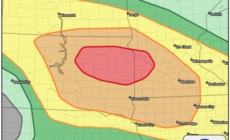-
Yankees Make Trade, Send Carlos Carrasco to Atlanta - 5 mins ago
-
Colorado’s Deion Sanders Had Bladder Removed Following Bladder Cancer Diagnosis - 9 mins ago
-
Multiple people wounded in shooting at Reno casino - 37 mins ago
-
High-powered attorney guns down socialite wife in front of her friend - 39 mins ago
-
Social Security Update: Senator Warns Agency Hiding ‘Extent of the Problem’ - 44 mins ago
-
Guardians’ Emmanuel Clase Placed on Leave Amid MLB’s Sports-Betting Investigation - 55 mins ago
-
High-powered attorney guns down socialite wife in front of her friend - about 1 hour ago
-
Map Shows States That Could See Hurricane-Force Winds - about 1 hour ago
-
Trump says baseline tariff rates for most countries will be in the 15-20% range - about 1 hour ago
-
Sydney Sweeney’s American Eagle ad slammed, accused of being ‘Nazi propaganda’ - 2 hours ago
COVID rising in California. How bad will this summer be?
COVID-19 is once again on the rise in California.
It remains to be seen whether this latest uptick foreshadows the sort of misery seen last year — when the state was walloped by its worst summertime surge since 2022 — or proves fleeting. But officials and experts say it’s nevertheless a reminder of the seasonal potency of the still-circulating virus.
“We definitely are seeing an uptick in the summer,” Dr. Erica Pan, director of the California Department of Public Health and the state health officer, said during a recent webinar.
As has often been the case with COVID, the latest increase in infections is not playing out uniformly across the state. The uptick was first registered in Northern California and only started being seen in Southern California more recently.
Dr. Elizabeth Hudson, regional physician chief of infectious diseases for Kaiser Permanente Southern California, said she expects an uptick in cases in the Southland over the next two to three weeks, based on the level of coronavirus being detected in wastewater.
“My colleagues at Northern California Kaiser Permanente have already noticed this trend, so I suspect it will be coming to Los Angeles soon,” Hudson said.
However, COVID activity remains well below the level seen last summer at this point — and it’s too soon to say how bad this season will be. While last summer saw a particularly potent spike in infections, this past winter was the mildest of the COVID era.
“We’ll know over the next couple of weeks which direction things are going,” Hudson said.
It remains possible that COVID could end up being as active as last year, if not worse, according to Dr. Peter Chin-Hong, an infectious disease expert at UC San Francisco.
“It’s been a longer time since a lot of people got infected,” Chin-Hong said, noting California’s last busy COVID season was about a year ago, and immunity has waned since then. “And just like last year, there are new variants afoot.”
Chin-Hong said he’s been hearing more people ask for advice about COVID recently. Doctors suggest taking common-sense steps to avoid getting sick, such as avoiding people who are ill, and getting up-to-date vaccines.
“Just because you had an easy case the last time doesn’t mean that you’ll have an easy case this time,” Chin-Hong said. “A lot of people I’ve talked to who’ve gotten COVID this year, it was a pretty vicious case that lasted a long time.”
According to the Centers for Disease Control and Prevention, the part of the country with the highest coronavirus wastewater activity level at the moment is the West. On the state level, the CDC says California has “moderate” coronavirus activity level in its sewage, as does Nevada, Texas, Mississippi, Kentucky and South Carolina. Florida has “high” activity and Louisiana, “very high” activity, federal data show.
Viral levels in wastewater have still been rising in many parts of the country, Chin-Hong said.
A possible silver lining is that Chin-Hong expects the rate of infected people who need hospitalization will continue to drop.
As of early July, the rate at which lab tests were coming back positive for coronavirus infection in California was 5.5%. That’s higher than at any point since last winter, but still relatively low, Pan said. On Thursday, the California Department of Public Health said viral levels in wastewater are 66% lower than they were at this time last year.
At this point last year, the COVID test positivity rate was 8.2%, and peaked at around 12% in August.
Coronavirus levels are considered high in the sewershed of San Jose and Palo Alto, according to the Santa Clara County Public Health Department.
“We’re seeing an increase in COVID transmission in some parts of the county over the past several weeks,” the agency said.
In San Francisco, coronavirus wastewater levels have also been rising — but remain lower than last summer’s surge, according to the local Department of Public Health.
In Los Angeles County, the rate at which coronavirus tests are coming back positive is rising. For the week ending July 12, the most recent for which complete data are available, 6.4% of specimens tested by labs were positive, up from 4.8% the prior week.
Coronavirus levels in L.A. County wastewater have been roughly flat in recent weeks, and are lower than the levels seen the past few summers.
“Overall, the data suggest a slight increase in COVID-19 activity in L.A. County, but nothing yet consistent with a significant summer ‘surge,’” the local Department of Public Health said.
The story is much the same in Orange County, where the COVID test positivity rate is at 6.3% and increasing, but “still below recent years for this time of the year,” according to Dr. Christopher Zimmerman, deputy medical director of the Orange County Health Care Agency.
COVID-related visits to the emergency room in Orange County remain stable, accounting for 1.1% of all ER visits, compared with around 4% in August 2024, Zimmerman said. COVID-related admissions remain flat, comprising only 0.6% of hospitalized patients in the county.
That metric hasn’t exceeded 1% since the winter, and is down from the 1.8% recorded at this time last year.
The California Department of Public Health’s medium-term forecast predicts a minor summer COVID wave that is expected to peak in late August, Pan said.
State scientists do expect that California will see either a stronger summer COVID wave or a more significant winter wave. They do not expect the state will see the one-two punch of seasonal surges that were typical during the COVID emergency era, Pan said.
The most dominant circulating subvariant now is NB.1.8.1, which has been dubbed “Nimbus.” But the fastest-growing strain nationwide is XFG, nicknamed after another type of cloud, “Stratus.”
Both are highly contagious, officials say — and Nimbus has been particularly associated with what patients describe as “razor blade throat,” feeling like their throats are studded with razor blades. However, current available vaccines are expected to cover these subvariants.
The California Department of Public Health recommends that everyone age 6 months and up “should have access and the choice to receive currently authorized COVID-19 vaccines, with an emphasis on protecting higher-risk individuals, such as infants and toddlers, pregnant individuals and others with risks for serious disease,” Pan said.
That’s stronger than the latest federal guidance, which reflects recent recommendations issued by the Trump administration.
The Trump administration dropped the recommendation that healthy children and healthy pregnant women be vaccinated for COVID-19. In formal documents, health officials offer “no guidance” as to whether pregnant women should get the vaccine, and ask that parents talk with a healthcare provider before getting the vaccine for their children.
“Last year, the Biden administration urged healthy children to get yet another COVID shot despite the lack of any clinical data to support the repeat booster strategy in children,” Health and Human Services Secretary Robert F. Kennedy Jr. said in a social media video announcing the changes.
Kennedy, who has denigrated vaccines over the years, did not elaborate on the rationale for altering the recommendation for pregnant women in the 58-second video.
Pan said there were some contradictions in the latest federal guidance, given that the Trump administration was recommending the COVID-19 vaccine for people at serious risk of severe illness — a group that includes pregnant women — “but then it was stated the COVID-19 vaccine is not recommended for pregnant women.”
A number of health groups, including the American Academy of Pediatrics and American Public Health Assn., have sued Kennedy in federal court, alleging he violated federal law by changing COVID-19 vaccine recommendations without scientific evidence.
In California, an estimated 37% of seniors have received at least one dose of the latest version of the COVID-19 vaccine, which was released in September. The rate is around 50% for much of the San Francisco Bay Area.
Senior vaccine coverage is roughly 40% in San Diego, Ventura, Santa Barbara and Sacramento counties, and around 30% in Los Angeles, Orange, Riverside and San Bernardino counties.
“Insurance coverage for COVID-19 vaccines is still in place,” Pan said.
A number of medical professional and scientific organizations are aligning to support scientific-based vaccine recommendations, Pan said, including the American Academy of Pediatrics, the American Medical Assn. and AHIP, an association of health insurance plans.
Alarmed at the Trump administration’s changes around vaccine policy, the Center for Infectious Disease Research and Policy at the University of Minnesota has launched a “vaccine integrity project,” which aims “to make recommendations for how vaccine use can remain grounded in the best available science, free from external influence,” according to a university statement.
California health officials are also warning that the proposed federal budget threatens to cut deep into public health.
The federal government is proposing to halve the budget for the CDC, Pan said this month, from $9.2 billion to $4.3 billion.
About 80% of the CDC’s funding goes to state and local health agencies, Pan said. Nearly half of the budget for the California Department of Public Health comes from the federal government, and about two-thirds of the state’s public health department budget is given to local health agencies.
The proposed federal budget would eliminate key centers and programs, such as the National Center for Chronic Disease Prevention and Health Promotion, as well as grants for hospital preparedness and preventive health and health services, Pan said. The proposal also suggests reducing by more than half funding for public health emergency preparedness, from $735 million to $350 million, Pan said.
In June, a COVID-19 immunization grant was not extended to California and expired, according to the state Department of Public Health.
“These federal funding cuts mean everyone in Los Angeles County will be at increased risk for transmitting and contracting infectious diseases,” the L.A. County Department of Public Health said in a statement to The Times.
The agency said it not only works to prevent and control infectious diseases, but also inspects more than 57,000 food facilities and restaurants, tests and issues alerts about beach water quality, looks over safety issues at healthcare facilities and responds to public health emergencies, such as the region’s recent wildfires.
“The President’s proposed budget … would continue a dismantling of core public health activities and severely reduce funding for federal public health grant programs, including a 55% cut to the CDC, our main source of federal grant funds,” the L.A. County Department of Public Health said.
L.A. County could lose more than $200 million in annual public health funding under the budget proposal, the agency added, which would eliminate or significantly cut funding for public health emergency preparedness, chronic disease prevention, vaccination efforts and worker safety programs.
Among the concerns is the sudden termination of more than $45 million in previously awarded federal grant funds that support infectious disease control efforts and lab capacity, vaccination campaigns and substance use prevention.
A federal court has temporarily paused the Trump administration’s efforts to claw back those federal funds, the county said.
“But if we do not win this case, that funding will be abruptly terminated, leading to layoffs of dozens of contract employees, terminated purchase orders, and reductions in funding for [community-based organizations] supported by these funds,” the county said.
Source link





























